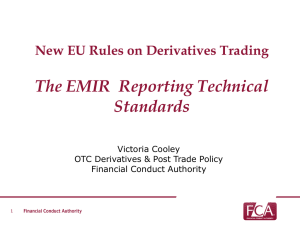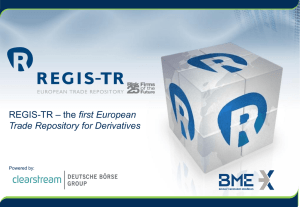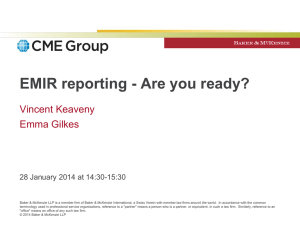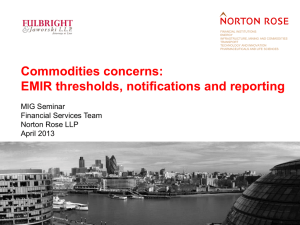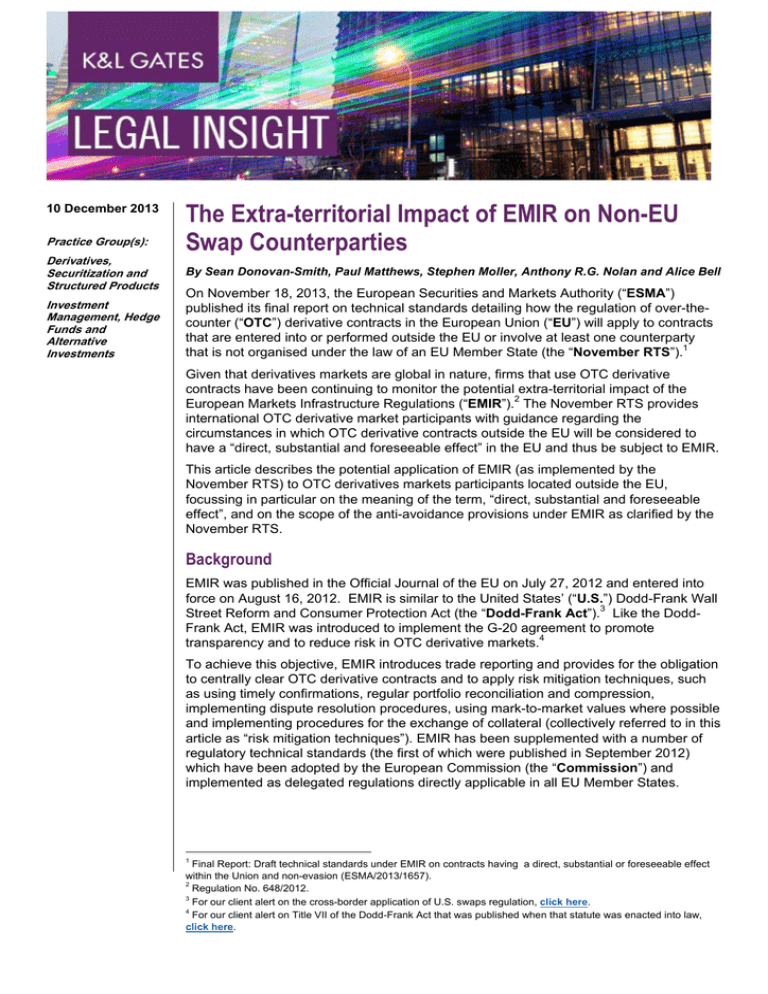
10 December 2013
Practice Group(s):
Derivatives,
Securitization and
Structured Products
Investment
Management, Hedge
Funds and
Alternative
Investments
The Extra-territorial Impact of EMIR on Non-EU
Swap Counterparties
By Sean Donovan-Smith, Paul Matthews, Stephen Moller, Anthony R.G. Nolan and Alice Bell
On November 18, 2013, the European Securities and Markets Authority (“ESMA”)
published its final report on technical standards detailing how the regulation of over-thecounter (“OTC”) derivative contracts in the European Union (“EU”) will apply to contracts
that are entered into or performed outside the EU or involve at least one counterparty
that is not organised under the law of an EU Member State (the “November RTS”).1
Given that derivatives markets are global in nature, firms that use OTC derivative
contracts have been continuing to monitor the potential extra-territorial impact of the
European Markets Infrastructure Regulations (“EMIR”).2 The November RTS provides
international OTC derivative market participants with guidance regarding the
circumstances in which OTC derivative contracts outside the EU will be considered to
have a “direct, substantial and foreseeable effect” in the EU and thus be subject to EMIR.
This article describes the potential application of EMIR (as implemented by the
November RTS) to OTC derivatives markets participants located outside the EU,
focussing in particular on the meaning of the term, “direct, substantial and foreseeable
effect”, and on the scope of the anti-avoidance provisions under EMIR as clarified by the
November RTS.
Background
EMIR was published in the Official Journal of the EU on July 27, 2012 and entered into
force on August 16, 2012. EMIR is similar to the United States’ (“U.S.”) Dodd-Frank Wall
Street Reform and Consumer Protection Act (the “Dodd-Frank Act”).3 Like the DoddFrank Act, EMIR was introduced to implement the G-20 agreement to promote
transparency and to reduce risk in OTC derivative markets.4
To achieve this objective, EMIR introduces trade reporting and provides for the obligation
to centrally clear OTC derivative contracts and to apply risk mitigation techniques, such
as using timely confirmations, regular portfolio reconciliation and compression,
implementing dispute resolution procedures, using mark-to-market values where possible
and implementing procedures for the exchange of collateral (collectively referred to in this
article as “risk mitigation techniques”). EMIR has been supplemented with a number of
regulatory technical standards (the first of which were published in September 2012)
which have been adopted by the European Commission (the “Commission”) and
implemented as delegated regulations directly applicable in all EU Member States.
1
Final Report: Draft technical standards under EMIR on contracts having a direct, substantial or foreseeable effect
within the Union and non-evasion (ESMA/2013/1657).
2
Regulation No. 648/2012.
3
For our client alert on the cross-border application of U.S. swaps regulation, click here.
4
For our client alert on Title VII of the Dodd-Frank Act that was published when that statute was enacted into law,
click here.
The Extra-territorial Impact of EMIR on Non-EU Swap
Counterparties
The Scope of EMIR
The extent to which EMIR applies to counterparties to derivative transactions depends on
whether the counterparty is established in the EU, and whether it is a Financial
Counterparty5 or a Non-financial Counterparty6 (and, if a Non-financial Counterparty, how
much derivative trading it carries out).
EMIR generally applies to all derivative contracts, central counterparties (“CCPs”),
Financial Counterparties, trade repositories and, in certain circumstances, to Nonfinancial Counterparties and trading venues. Non-financial Counterparties are further
categorised by the size of their trading activity (subject to exceptions for hedging
purposes): Non-financial Counterparties whose trading activity exceeds €1 billion in gross
notional value for OTC credit and equity derivatives, or €3 billion in gross notional value
for interest rate, foreign exchange, commodities and other derivatives are categorised as
“NFC+ Counterparties”.
The clearing and risk mitigation provisions of EMIR may apply to non-EU counterparties
in certain circumstances. However, as discussed below, EMIR and the November RTS
provide for “equivalency” mechanisms to avoid duplicative or conflicting rules, which are
in principle similar to the concept of substituted compliance in U.S. regulation under the
Dodd-Frank Act.
Application of the EMIR Clearing Obligations
The EMIR clearing obligation will apply to standardised OTC derivative contracts
between:
i.
EU Financial Counterparties and/or NFC+Counterparties; or
ii.
either an EU Financial Counterparty or an NFC+ counterparty and a non-EU entity
that would fall within the definition of a Financial Counterparty or a NFC+
Counterparty if such non-EU entity was established in the EU; or
iii.
two Non-EU counterparties that would each be either a Financial Counterparty or
NFC+ Counterparty were they established in the EU, provided the contract has a
“direct, substantial and foreseeable effect” within the EU7 or otherwise where
necessary or appropriate to prevent the evasion of EMIR. 8
5
The term “financial counterparty” covers several types of entity regulated by EU financial services legislation
(“Financial Counterparty”). That is, any investment firm that is authorised under the EU’s Markets in Financial
Instruments Directive (“MiFID”); any UCITS fund and its related management company; credit institutions; insurance
companies; and alternative investment funds managed by alternative investment fund managers authorised or
registered under the EU’s Alternative Investment Fund Managers Directive (“AIFMD”).
6
The term “non-financial counterparty” covers an entity established in the EU that is not a Financial Counterparty
(“Non-financial Counterparty” or “NFC”).
7
Article 4(1)(a)(v) EMIR. Counterparties to an OTC derivative contract subject to EMIR will likely be required to
consider adhering to the ISDA 2013 EMIR NFC Representation Protocol. For our alert addressing some factors to
be considered in deciding whether or not to adhere to that the merits and demerits of adhering to this protocol in
particular cases, please click here.
8
Article 11(12) EMIR.
2
The Extra-territorial Impact of EMIR on Non-EU Swap
Counterparties
NFC
NFC+
FC
Non-EU
“NFC”
Non-EU
“NFC+”
Non-EU
“FC”
NFC
NFC+
FC
Non-EU
“NFC”
Non-EU
“NFC+”
*
*
Non-EU
“FC”
*
*
*only if a “direct, substantial and foreseeable effect” within the EU or for anti-avoidance purposes.
Application of the EMIR Risk Mitigation Techniques
The requirement under EMIR to employ risk mitigation techniques applies when OTC
derivative contracts that are not cleared by a CCP are concluded between:
i.
EU Financial Counterparties and Non-financial Counterparties; or
ii.
a non-EU entity and an EU Financial Counterparty or Non-financial Counterparty
on the basis that the relevant EU counterparty is itself subject to the EMIR risk
mitigation techniques requirements;9 or
iii.
non-EU entities that would each be either a Financial Counterparty or Nonfinancial Counterparty if they were established in the EU, provided the contract
has a “direct, substantial and foreseeable effect” within the EU, or otherwise
where necessary or appropriate to prevent the evasion of EMIR.10 (Note that
different risk mitigation techniques apply to Non-financial Counterparties
depending on whether they are a Non-financial Counterparty or a NFC+
Counterparty.)
9
N.B. the obligation under EMIR attaches to the counterparties and not to the contract. In this scenario, the non-EU
counterparty is not directly within scope of EMIR and need only have in place compliant procedures to the extent it
wishes to transact with EU counterparties who are directly within scope.
10
Article 11(12) EMIR.
3
The Extra-territorial Impact of EMIR on Non-EU Swap
Counterparties
NFC
FC
Non-EU “NFC”
Non-EU “FC”
NFC
*
*
FC
*
*
Non-EU “NFC”
*
*
**
**
Non-EU “FC”
*
*
**
**
*The non-EU counterparty is only indirectly caught.
**Only if a “direct, substantial and foreseeable effect” within the EU or for anti-avoidance purposes.
Direct, substantial and foreseeable effect in the EU
The November RTS provide that the clearing obligation would only apply when the two
non-EU counterparties’ jurisdictions’ rules are not considered equivalent to EMIR11 and
where one of the following conditions are met:
i.
the contract is guaranteed by an EU Financial Counterparty; or
ii.
the transaction is executed via the EU branches of the two non-EU counterparties.
Guarantees
The November RTS provide that if an OTC derivative contract is entered into by a nonEU counterparty benefiting from a guarantee issued by an EU Financial Counterparty,
the OTC derivative contract will be deemed to have a direct effect in the EU ‒ i.e., where
the guarantor is established. This reflects ESMA’s view that, where a swap between nonEU counterparties is guaranteed by an EU guarantor, the default of the guaranteed
counterparty would have a direct effect on the EU guarantor, which would be obliged to
assume the resulting liability.
The definition of “guarantee” contained in the November RTS refers to “explicitly
documented legal obligation[s]” and therefore excludes implicit guarantees and letters of
comfort (unless drafted as a legal obligation of the issuer), credit derivatives (already
covered by EMIR) and contracts of insurance.
In order for a guaranteed OTC derivative contract to be covered by the November RTS,
the guarantee must cover OTC derivatives contracts with a gross notional amount of at
least €8 billion and the guaranteed obligations must represent at least 5 percent of the
aggregate current exposure of the guarantor on OTC derivatives contracts. (Where a
guarantee covers a percentage of the liability resulting from an OTC derivative contract,
the proportion of the notional amount covered by the guarantee will be counted toward
the €8 billion threshold described above.) ESMA rejected suggestions raised in its
consultation that the threshold should be calculated on a net basis.
The calculations should be applied to individual legal entities rather than at the group
level, and a proportionate amount should be applied if the guarantee is split across
several guarantors.
11
Pursuant to the mechanisms to avoid duplicative or conflicting rules, under Article 13 of EMIR and recital (2) of the
November RTS (i.e., equivalence).
4
The Extra-territorial Impact of EMIR on Non-EU Swap
Counterparties
The November RTS only capture guarantees that have been issued by a Financial
Counterparty (i.e., established in the EU). Despite requests from industry stakeholders
during the consultation period that ESMA restrict this further to Financial Counterparties
that are parents of the guaranteed non-EU counterparty, the November RTS do not
require an affiliation between the guarantor and the guaranteed entity.
Note that OTC derivative contracts concluded after August 16, 2012 but which
subsequently are covered by an applicable guarantee will nevertheless be counted
towards the cumulative quantitative threshold if they are considered to have a direct,
substantial and foreseeable effect in the EU (and are thereby potentially subject to
EMIR).
Branches
In determining whether OTC transactions by the EU branch of a non-EU entity are
subject to EMIR, the November RTS adopts a rule based on the location and identity of
the branch’s counterparty.
If the EU branch of a non-EU entity transacts either with an EU entity or with the EU
branch of another non-EU entity, the November RTS will cause that derivative contract to
be deemed to have a direct effect on the EU and thereby fall within the scope of EMIR.
ESMA’s reasoning for this rule is that such EU branches may not be caught by non-EU
regimes and the non-EU entity’s jurisdiction may not be equivalent to Europe, potentially
leading to a loophole, with a consequential direct effect in the EU.
On the other hand, EMIR will not apply to an OTC derivative contract between an EU
branch of a non-EU entity and another non-EU entity pursuant to the November RTS
because ESMA considers such a scenario to be a cross-border transaction that does not
have a direct effect in the EU.
Non-evasion of EMIR
The November RTS use a “primary purpose” criteria-based approach to define the types
of OTC derivative transactions that are deemed to be concluded for the purpose of
circumventing EMIR.
The November RTS provide that an OTC derivative contract with the primary purpose of
avoiding provisions of EMIR that would otherwise apply will be caught by the evasion
provision, for example, if the contract is part of an “artificial arrangement”. An artificial
arrangement is one “that intrinsically lacks business rationale, commercial substance or
relevant economic justification”. When determining the “primary purpose” of a contract,
the November RTS stipulate that the way in which the contract was concluded should be
viewed as a whole and with regard to all the circumstances. This determination will need
to be made on a case-by-case basis.
Timing
The November RTS will only take effect once adopted by the European Commission and
they subsequently enter into force.12 Accordingly, the clearing and risk mitigation
obligations will not apply to non-EU counterparties who enter into OTC derivative
contracts having a “direct, substantial and foreseeable effect” within the EU or to those
deemed to be concluded for the purpose of evading EMIR until such time. However,
Non-EU counterparties may nonetheless inadvertently be caught by the risk mitigation
12
Pursuant to Recital 93 of EMIR.
5
The Extra-territorial Impact of EMIR on Non-EU Swap
Counterparties
obligation if they transact with EU counterparties who are themselves required to comply,
because such counterparties must have written agreements in place with their
counterparties, dealing with the risk mitigation obligations.
The European Commission has until February 15, 2014 to decide whether to endorse the
November RTS and, provided it does endorse the November RTS (which is expected),
the European Commission must then submit the endorsed standards to the European
Parliament and the Council of Europe. The November RTS would then enter into force
20 days after publication in the Official Journal of the EU, but the provisions relating to
contracts that have a direct, substantial and foreseeable effect in the EU would be
subject to a transition period of six months.
With the exception of the cumulative quantitative threshold for guarantees, the provisions
relating to contracts having a direct, substantial and foreseeable effect in the EU will only
apply to OTC derivative contracts entered into after the November RTS take effect.
Equivalence / Substituted Compliance
Because of the global nature of OTC derivatives markets and the firms that participate in
them, many market participants have been very concerned about the risk that they could
be subject to duplicative or conflicting rules. In certain circumstances, the EMIR clearing
and risk mitigation obligations may be substituted by equivalent requirements in third
countries for cross-border transactions and transactions between two third country
entities.
EMIR and the November RTS acknowledge those concerns by addressing the need to
give due consideration to the mechanism to avoid duplicative or conflicting rules provided
by EMIR, which is based on equivalence of the legal, supervisory and enforcement
arrangements of third countries. The November RTS make clear that, if one of the two
counterparties to a transaction is established in a third country for which the Commission
has adopted an implementing act declaring that third country to be equivalent, both
counterparties to the relevant transaction will be deemed to have complied with EMIR by
applying the equivalent rules of the third country. 13 This is in principle similar to the
notion of “substituted compliance” articulated by U.S. regulators such as the Commodity
Futures Trading Commission (the “CFTC”) and the Securities and Exchange
Commission. However, the scope and application of mechanisms for equivalence in the
EU or substituted compliance in the U.S. are not identical.
ESMA has stated that close cooperation between supervisors is required to regulate
derivative markets in an efficient and adequate manner and to address risks while
preventing duplication and overlap of regulation or regulatory gaps. ESMA’s
determination of the availability of relief to avoid duplicative regulation will likely be based
on its evaluation of the timing and scope of the solutions put forth by competent
regulatory authorities in particular jurisdiction.14
An important further development will be the negotiations among regulators
internationally, particularly between those in the EU and those in the U.S., to determine
the details governing decisions on equivalence and the circumstances under which an
entity’s compliance with its home country regulations will be deemed to be compliant with
the regulations being applied with extraterritorial effect. In order to avoid the risk that the
13
Article 13 of EMIR and recital (2) of the November RTS.
As at the date of this article, ESMA has provided the Commission with technical advice on the equivalence of nine
countries (Australia, Canada, Hong Kong, India, Japan, Singapore, South Korea, Switzerland and the U.S.). By way
of comparison, the CFTC has identified Australia, Canada, the EU, Hong Kong, Japan, and Switzerland as having
regulations that may qualify for substituted compliance.
14
6
The Extra-territorial Impact of EMIR on Non-EU Swap
Counterparties
OTC derivatives market may fragment along regional or national lines, it will be
particularly important for the Commission to take appropriate equivalence decisions with
respect to, and for ESMA to grant recognition of, CCPs located outside the EU, just as it
will be important for the CFTC to take appropriate targeted no-action relief with respect to
CCPs located outside the U.S.15 To ensure the seamless working of the clearing
mechanism for OTC derivatives and swaps, and to avoid uncertainty around clearing
obligations, the Commission and the CFTC must endeavour to ensure that those
infrastructures will be able to clear swaps/derivatives for their clearing members until
registration/recognition has been determined. The EU can achieve this through the
Commission’s equivalence decisions and ESMA’s recognition of foreign CCPs, while the
CFTC can do this through targeted no-action relief.
Conclusion
The publication of the November RTS marks an important step in the development of a
regulatory scheme for OTC derivatives in the EU. Firms that deal in OTC derivative
contracts should review their arrangements to determine whether they are within the
scope of EMIR and to ensure that they are aware of any obligations that may apply to
them. Firms based outside the EU but who transact with counterparties in the EU or
through branches located in the EU should consider their OTC derivatives trading
activities with care to ensure that their transactions are consistent with EU regulation,
including through making of appropriate EMIR protocol representations.
Key Contacts:
Sean Donovan-Smith
Paul Matthews
Anthony R. G. Nolan
Alice Bell
sean.donovan-smith@klgates.com
+44.(0)20.7360.8202
paul.matthews@klgates.com
+44.(0).20.7360.8214
anthony.nolan@klgates.com
+1.(212).536.4843
alice.bell@klgates.com
+44.20.7360.8304
Stephen Moller
stephen.moller@klgates.com
+44.20.7360.8212
15
As at the date of this article two EU CCPs (LCH.Clearnet Ltd. and ICE Clear Europe) are already registered with
the CFTC as derivatives clearing organizations under the Dodd-Frank Act. We understand that the CFTC’s Division
of Clearing and Risk plans to issue no-action letters to Eurex Clearing AG and LCH.Clearnet SA, both of which have
pending registration applications with the CFTC, to begin clearing interest rate swaps and/or credit default swap
indices for U.S. clearing members.
7
The Extra-territorial Impact of EMIR on Non-EU Swap
Counterparties
Anchorage Austin Beijing Berlin Boston Brisbane Brussels Charleston Charlotte Chicago Dallas Doha Dubai Fort Worth Frankfurt
Harrisburg Hong Kong Houston London Los Angeles Melbourne Miami Milan Moscow Newark New York Orange County Palo Alto
Paris Perth Pittsburgh Portland Raleigh Research Triangle Park San Diego San Francisco São Paulo Seattle Seoul Shanghai
Singapore Spokane Sydney Taipei Tokyo Warsaw Washington, D.C. Wilmington
K&L Gates practices out of 48 fully integrated offices located in the United States, Asia, Australia, Europe, the
Middle East and South America and represents leading global corporations, growth and middle-market
companies, capital markets participants and entrepreneurs in every major industry group as well as public
sector entities, educational institutions, philanthropic organizations and individuals. For more information
about K&L Gates or its locations, practices and registrations, visit www.klgates.com.
This publication is for informational purposes and does not contain or convey legal advice. The information herein should not be used or relied upon
in regard to any particular facts or circumstances without first consulting a lawyer.
©2013 K&L Gates LLP. All Rights Reserved.
8

